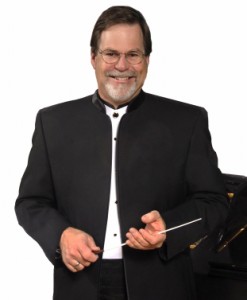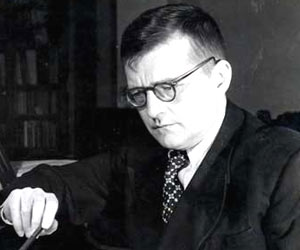Ever since Robert Baldwin was appointed music director of the Salt Lake Symphony, he hasn’t shied away from programming works that challenge his orchestra. “They want to play great repertoire,” he told Reichel Recommendsrecently in a phone interview. “How good is a community orchestra? I don’t know, but I do know we keep growing [musically] and getting better.”
For his 10th season opener Saturday with what is without question one of the top community orchestras in the state, Baldwin has chosen a work that will certainly test the mettle of his players: Dmitri Shostakovich’s Symphony No. 10 in E minor. “It’s very demanding,” he said. “On our first read through it seemed nearly impossible.” But as rehearsals progressed, it began to make sense. “Once you realize there are the same kinds of repetitions you find among other Russian composers, like Tchaikovsky or Rimsky-Korsakov, then you see there is a cohesiveness to it.”
Baldwin is a big fan of Shostakovich’s music. What attracts him to it is the personal element that’s attached to these works. “You find that almost all of his works are autobiographical. They detail his struggle, and his ultimate triumph. The Tenth ends much like Beethoven’s Fifth, but [the Tenth] has a much more festive final movement.”
One of Shostakovich’s favorite devices is to fashion melodies out of the musical letters of his last name: D, S (E flat), C and H (B). “I’m a sucker for that,” Baldwin confessed, adding that the manner in which the composer uses this theme in the Tenth is much more powerful than its appearances in other works. “It’s done more forcefully here. It’s much more effective.”
Shostakovich had always had a tenuous relationship with Josef Stalin and the Communist Party. He and his works had been condemned twice by the Politburo, once in the 1930s and again a decade later. If one is to believe what has been said and written about the genesis of the Tenth, the work deals with the Soviet dictator, who died about six months before it was premiered in 1953. Shostakovich also admitted as much, and one can indeed hear the composer’s struggles with the Soviet establishment. And the fourth movement can certainly be taken to represent the individual’s triumph over conformity. But whatever the basis was for this symphony one thing is certain, as Baldwin pointed out: “The great thing about Shostakovich’s music is that you don’t need to know the story behind the works to enjoy them. You can appreciate his music right from the first hearing. You can enjoy it for what it is: good music that is well written.”
Opening the concert will be an audience favorite that is as far removed from Shostakovich’s anguished world as one can get: the overture to Leonard Bernstein’s Candide. “The Shostakovich is so dark I wanted to open with something peppy,” Baldwin said. “And it’s a piece that the orchestra has requested for years.”
Looking over his decade-long tenure as music director, Baldwin said there have been many highlights. “One of the great things we have done is collaborating with a number of soloists. That’s really elevated our playing.” Among the guests who have played with the orchestra that Baldwin mentioned are Monica Jalili and her Persian Ensemble; and the Utah Symphony’s John Eckstein playing the Elgar Cello Concerto and Ron Beitel playing Mozart’s Horn Concerto No. 2. “After he played the concerto, Ron joined the orchestra’s horn section. That meant a lot to everybody.”
Below is a schedule for the Salt Lake Symphony’s 2014-15 season. All concerts begin at 7:30 p.m. and take place in Libby Gardner Concert Hall on the University of Utah campus, unless otherwise noted. For more information log on to www.saltlakesymphony.org.
- Sept. 27 — “Celebrating Ten Years.” Music by Bernstein and Shostakovich.
- Nov. 15 — “Cultural Roots.” Music by Beethoven, John Williams and Dvorák; featuring Ryan van Liere, bassoon.
- Dec. 6, 2 p.m and 7:30 p.m. — “Christmas Eve Magic.” Music by Tchaikovsky.
- Jan. 17, 2015, 2 p.m. — “Music, the Final Frontier.” Family Concert.
- Jan. 24, 2015 — “SummerArts Piano Competition Winners Concert.”
- Feb. 14, 2015, 8 p.m. (Olpin Union Ballroom). “Vienna Ball.”
- March 21, 2015 — “Fire and Ice!” Music by Sibelius, Stravinsky and Vaughan Williams.
- April 25, 2015 — “Utah Talent Spotlight.” Music by John Costa, Beethoven and Mendelssohn; featuring Shenae Anderson, violin, with Barbara Scowcroft, guest conductor.
- May 30, 2015 — “Let There Be Light!” Music by Haydn; featuring Utah Voices.
- CONCERT DETAILS
- What: Salt Lake Symphony, Robert Baldwin, conductor
- Venue: Libby Gardner Concert Hall, University of Utah
- Time and Date: 7:30 p.m. Sept. 27 (Please note: There is a University of Utah home football game that evening; plan on arriving in enough time to find parking.)
- Tickets: $10 general, $5 seniors/students, at the door
- Phone: 801-531-7501
- Web: www.satlakesymphony.org


